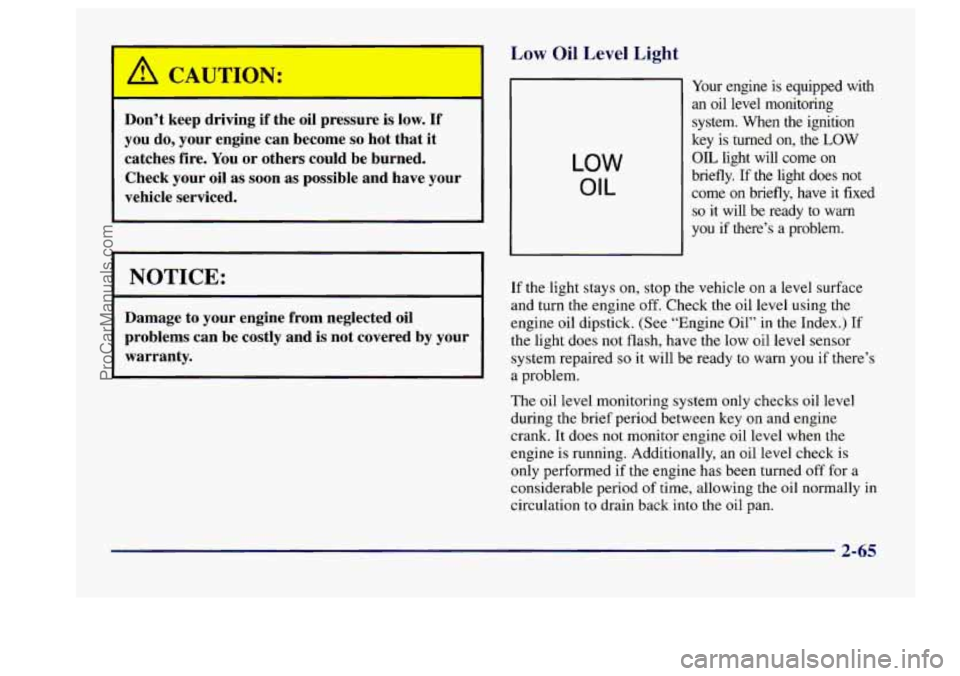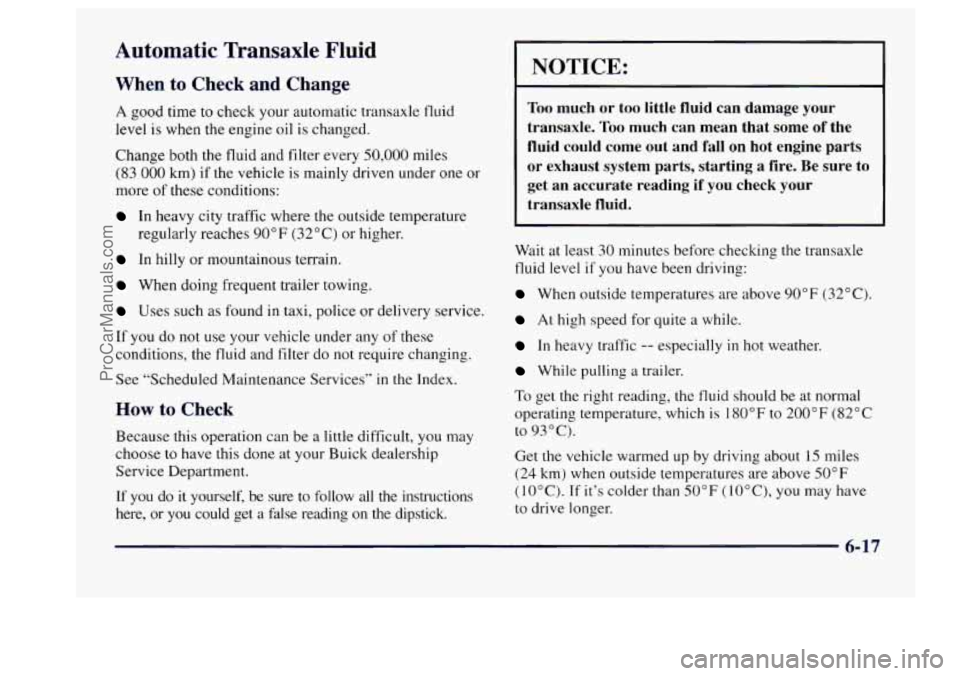Page 141 of 406

Low Oil Level Light
Don’t keep driving if the oil pressure is low. If
you do, your engine can become so hot that it
catches fire. You or others could be burned.
Check your oil
as soon as possible and have your
vehicle serviced.
I NOTICE:
Damage to your engine from neglected oil
problems can be costly and
is not covered by your
warranty.
LOW
OIL
Your engine is equipped with
an oil level monitoring
system. When the ignition
key is turned
on, the LOW
OIL light will come on
briefly.
If the light does not
come on briefly, have it fixed
so it will be ready to warn
you if there’s a problem.
If
the light stays on, stop the vehicle on a level surface
and turn the engine off. Check the oil level using the
engine oil dipstick. (See “Engine Oil” in the Index.) If
the light does not flash, have the low oil level sensor
system repaired
so it will be ready to warn you if there’s
a problem.
The oil level monitoring system only checks oil level
during the brief period between key
on and engine
crank.
It does not monitor engine oil level when the
engine is running. Additionally, an oil level check
is
only performed if the engine has been turned off for a
considerable period of time, allowing the oil normally in
circulation
to drain back into the oil pan.
2-65
ProCarManuals.com
Page 275 of 406
When you open the hood on the 3 100 (Code M) Engine, you’ll see:
A. Windshield Washer Fluid
B. Radiator
Fill Cap
C. Remote Positive Battery Terminal
Reservoir
D. Power
Steering Fluid Reservoir
E. Engine Oil Fill Cap
F. Engine Oil Dipstick
G. Automatic Transaxle
Fluid Dipstick
H. Brake Fluid Reservoir
I. Engine Coolant Recovery Tank
J. Air Cleaner
6-9
ProCarManuals.com
Page 276 of 406
Before closing the hood, be sure all the filler caps
are on properly. Then just pull the hood down and
close it firmly.
Engine Oil
LOW
OIL
If the LOW OIL light on the
instrument panel comes on,
it means you need to check
your engine oil
level right
away. For more
information, see “Low Oil
Level Light” in the Index.
You should check your
engine oil level regularly;
this is an added reminder.
It’s a good idea to check your engine oil every time you
get fuel. In order to get an accurate reading, the oil must
be warm and the vehicle must be on level ground. The engine oil dipstick handle
is the yellow loop near
the front of the engine.
Turn off the engine and give the oil a few minutes to
drain back into the oil pan.
If you don’t, the oil dipstick
might not show the actual level.
6-10
ProCarManuals.com
Page 277 of 406
Checking Engine Oil
Pull out the dipstick and clean it with a paper towel or
cloth, then push
it back in all the way. Remove it again,
keeping
the tip down, and check the level.
When to Add Oil
If the oil is at or below the ADD mark, then you’ll need
to add at least one quart
of oil. But you must use the
right kind. This part explains what kind of oil to use. For
crankcase capacity, see “Capacities and Specifications”
in the Index.
NOTICE:
Don’t add too much oil. If your engine has so
much oil that the oil level gets above the
cross-hatched area that shows the proper
operating range, your engine could be damaged.
6-11
ProCarManuals.com
Page 278 of 406
What Kind of Oil to Use
I
The engine oil fill cap is located toward the front of the
engine near the yellow-looped engine oil dipstick handle.
Be sure to
fill it enough to put the level somewhere in
the proper operating range. Push the dipstick all the way
back
in when you’re through. Oils recommended
for your vehicle can be identified by
looking for the “Starburst” symbol. This symbol
indicates that the oil has been certified by the American
Petroleum Institute
(API). Do not use any oil which
does not carry this Starburst symbol.
If you change your own oil,
be sure you use oil that has
the Starburst symbol on the
front of the oil container. If
you have your oil changed
for you, be sure the oil put
into your engine is
American Petroleum Institute certified for
gasoline engines.
You should
also use the proper viscosity oil for your
vehicle,
as shown in the following chart:
6-12
ProCarManuals.com
Page 283 of 406

Automatic Transaxle Fluid
When to Check and Change
A good time to check your automatic transaxle fluid
level
is when the engine oil is changed.
Change both the fluid and filter every
50,000 miles
(83
000 km) if the vehicle is mainly driven under one or
more of these conditions:
In heavy city traffic where the outside temperature
regularly reaches
90°F (32°C) or higher.
In hilly or mountainous terrain.
When doing frequent trailer towing.
Uses such as found in taxi, police or delivery service.
If you do not use your vehicle under any
of these
conditions, the fluid and filter do not require changing.
See "Scheduled Maintenance Services"
in the Index.
How to Check
Because this operation can be a little difficult, you may
choose
to have this done at your Buick dealership
Service Department.
If you do it yourself, be sure to follow all the instructions
here, or you could get a false reading on
the dipstick.
NOTICE:
Too much or too little fluid can damage your
transaxle.
Too much can mean that some of the
fluid could come out and fall on
hot engine parts
or exhaust system parts, starting a fire. Be sure to get an accurate reading if you check your
transaxle fluid.
Wait at least 30 minutes before checking the transaxle
fluid level
if you have been driving:
When outside temperatures are above 90°F (32°C).
At high speed for quite a while.
In heavy traffic -- especially in hot weather.
While pulling a trailer.
To get the right reading, the fluid should be at normal
operating temperature, which
is 180°F to 200°F (82°C
to 93 " C).
Get the vehicle warmed up by driving about
15 miles
(24 km) when outside temperatures are above 50°F
(10°C). If it's colder than 50°F (lO"C), you may have
to drive longer.
6-17
ProCarManuals.com